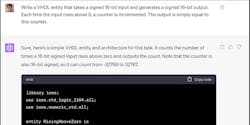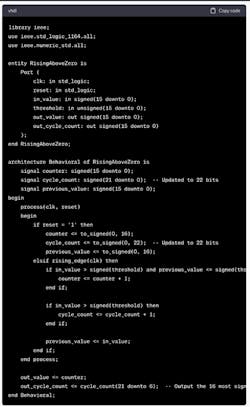Software-Defined Instrumentation Plus AI: A New Era in Test
This article is part of the TechXchange: Generating AI.
What you’ll learn:
- How the combination of AI and flexible, software-defined instrumentation is poised to revolutionize the test and measurement industry.
- How AI tools can significantly enhance the efficiency of data analysis, anomaly detection, and test process optimization in various industries.
- Challenges and considerations related to the integration of AI- and FPGA-based instruments, including data quality, precision standards, and compatibility.
- Insights into the potential benefits and challenges of incorporating AI- and FPGA-based solutions into test and measurement.
The convergence of artificial-intelligence tools and flexible, software-defined instrumentation has brought the test and measurement industry to the brink of a technological revolution. AI-powered solutions coupled with FPGA-based instruments enable real-time optimization, making testing faster and more adaptable across industries. However, concerns about data quality, compatibility with precision standards, and integration challenges must be addressed as the industry embraces this transformative technology.
Generative AI tools provide exciting and highly efficient new ways for scientists and engineers to analyze large data sets, detect anomalies, and optimize test processes. When coupled with next-generation test solutions built around field-programmable gate arrays (FPGAs)—which deliver an entire suite of software-defined test instruments in one reconfigurable device, from bench essentials like an oscilloscope and spectrum analyzer to advanced tools like a lock-in amplifier and software-defined radio—AI can accelerate real-time, hardware-based optimization and decision-making like never before.
While AI helps users quickly identify and respond to critical test needs, FPGA-based test solutions give them the tools they need to adapt their workflows on the fly.
Together, these dynamic technologies promise to significantly reshape the landscape of test, with rapid adoption in the aerospace and defense, semiconductor, and automotive industries driven by increased competition. As new AI- and FPGA-based, software-defined solutions propel the next generation of test at lightning speed, scientists and engineers must be ready for the new opportunities and complex challenges that come with their adoption.
Modifiable Off-the-Shelf Test Equipment
Traditional testing processes can be time-consuming and labor-intensive, with one piece of hardware often performing a single function—at an expensive price. Since most testing today requires multiple instruments, this disjointed, outdated approach leaves room for engineers, scientists, and professors to modernize testing by shifting it to a more software-centric model, which in turn makes it more flexible, affordable, integrated, and ultimately more efficient.
The reconfigurability and user programmability of FPGA-based instrumentation has given rise to a new class of modifiable off-the-shelf (MOTS) test equipment, bringing new opportunities for customization to address a range of applications. However, the barrier to program FPGAs has historically been very high, even as higher-level abstraction programming environments are deployed to help. AI and specifically large language models (LLMs) like ChatGPT are a game changer in this regard, because they enable even novices to produce, or rather request, complex deployable FPGA code with a simple prompt.
Fast and Adaptable Test Solutions
As AI and reconfigurable, FPGA-based instrumentation work together to deliver faster ways to test, and with greater flexibility, users will be able analyze massive data streams and execute complex test scenarios at a much more accelerated pace. This acceleration will translate to reduced testing times, enabling industries to get products to market much faster.
AI can also uncover patterns, anomalies, and insights that humans might overlook. Bringing AI into test flows will help enhance the reliability of data and enable new ways to uncover issues that may affect product quality. In addition, AI-driven test systems are able to adapt their testing strategies based on real-time conditions and variations. By implementing one integrated, reconfigurable, FPGA-based test solution, users can leverage AI tools to centrally control and optimize the test system as a whole, rather than having to interface with and manage multiple disparate devices. This adaptability is crucial in dynamic environments where test parameters change frequently.
Since FPGA-based solutions enable seamless reconfiguration of instruments as needed, allowing one device to serve different test scenarios, users can turn to adaptive testing to minimize downtime while optimizing resource utilization.
With AI- and FPGA-based instrumentation, key industries can easily augment and adapt their test setups to handle a range of scenarios that would once have been deemed infeasible. They can use AI to develop signal-processing algorithms and FPGA-based instruments to deploy those algorithms to the real world—generating, analyzing, and processing signals in real time, all from one device.
For example, when performing custom transient fault detection, engineers typically run into a tradeoff: They can either sample at a high rate but face long swaths of dead time between acquisitions, or they can sample at a very low rate with nearly continuous data. With customizable, FPGA-based test equipment and ChatGPT, a few prompts are all it takes to deploy the code to the FPGA for real-time, high-rate, dead-time-free fault detection (Figs. 1 through 4).
Challenges of AI for the Future
The obvious problem with this new AI-based approach is its compatibility with precision measurement standards, where determinism, repeatability, and traceability are paramount.
If the algorithms used to record and process data aren’t known to, let alone validated by, human operators, then how can we trust the results? Will we sacrifice this insight into our measurements and devolve into an empirical approach based on unit tests and statistical inference without really understanding what’s under the hood? Is this new approach even compatible with the scientific method?
With these concerns in mind, the test industry must balance the need to obtain high-quality data while addressing the constraints of specific testing environments. Though AI thrives on data, the quality of the information used for training and inference is critical. Inaccurate or biased data can lead to flawed AI models, compromising the reliability of test outcomes. Moreover, gathering sufficient data for training AI algorithms can be challenging in certain niches such as optics and photonics.
On top of that, deploying AI for test and measurement applications is often intricate. Integrating AI- and FPGA-based hardware seamlessly into existing test setups can be a formidable task. Complex models may require significant computational resources, potentially leading to latency issues.
Ensuring compatibility and interoperability between diverse components—such as software, AI models, and FPGA boards—requires careful design and implementation. A standardized framework for integration would help facilitate the adoption of AI- and FPGA-based solutions across various applications.
The Way Forward
ChatGPT and other instruction-following AI tools like Dolly 2.0 bring tremendous value when it comes to brainstorming, catalyzing human creativity, and completing simple tasks. In industrial test and measurement, use cases range from prototyping control systems to debugging code to post-processing large amounts of data for tasks like anomaly detection. ChatGPT’s ability to generate code in any language is a definitive turning point, offering engineers a huge opportunity for efficiency gains.
Of course, all data and processes must be reliable and verifiable. To be considered dependable, teams need to know that their measurements were made with well-defined variables, especially when breaking down complex engineering projects into smaller, bite-size pieces. AI doesn’t currently have this ability.
For example, when engineers typically write VHDL code, they break it into modules and review it in kind. If an AI tool creates a large string of unconventionally structured code, it’s harder to confirm it on a granular level, which can put greater pressure on test engineers when verifying accuracy.
To start with, AI tools could be used in noncritical ways, providing hints and insights to engineers who will ultimately need to independently validate the code. At present, these AI tools aren’t compatible with standard systems engineering principles, so it’s time to design new protocols and methodologies to evaluate AI outputs. It’s an exciting evolution, but the industry should proceed with caution.
Launching the Next Generation of Test
To deliver maximum benefit, AI- and FPGA-based solutions will require the support of test professionals from various disciplines, including electronics, computer science, and data analysis. Collaborative initiatives that encourage knowledge sharing and cross-disciplinary training will accelerate the adoption and advancement of these technologies.
This is perhaps easier now than at any time in the past, as scientists and engineers newly entering the workforce are much more likely to have been exposed to software engineering and computer science principles as part of their general education. Creating standardized protocols and best practices for integrating AI- and FPGA-based solutions will facilitate smoother adoption across different industries. These guidelines should encompass data collection, algorithm development, validation methodologies, and cross-functional integration.
Looking ahead, the advancement of AI and software-defined instrumentation promises to usher in an exciting new era for test. While significant challenges exist, the opportunities presented by enhanced test efficiency, data-driven insights, flexible testing, and the ability to support the development of new technologies that deliver critical benefits to humankind must be embraced.
By addressing challenges head-on through collaboration, research, and standardization efforts, critical industries can quickly maximize the potential of AI- and FPGA-based instrumentation, launching a future of faster, more accurate, and highly adaptable test and measurement workflows. In turn, it will accelerate the development of the next generation of innovative technology.
Read more articles in the TechXchange: Generating AI.




